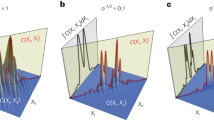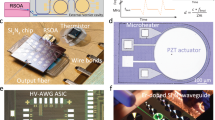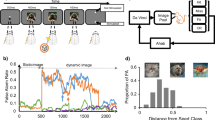Abstract
Portions of surfaces in a binocularly viewed scene may be 'half occluded', that is, visible in only one eye. The human visual system uses zones of half occlusion to help segment the visual scene and infer figure–ground relationships at object boundaries. We developed a quantitative model of the depth-discontinuity cue provided by half occlusion. Half occlusions are revealed by two-dimensional interocular displacements of binocularly viewed occlusion junctions, such as T junctions. We derived a formula relating this two-dimensional displacement, or 'pseudodisparity', to binocular disparities and orientations of occluding and occluded contours. In human psychophysical experiments, perceived depth and contour orientation quantitatively depended on pseudodisparity, as predicted by our model, implying that the visual system senses quantitative variations in interocular junction position to reconstruct occlusion geometry.
This is a preview of subscription content, access via your institution
Access options
Subscribe to this journal
Receive 12 print issues and online access
$209.00 per year
only $17.42 per issue
Buy this article
- Purchase on Springer Link
- Instant access to full article PDF
Prices may be subject to local taxes which are calculated during checkout




Similar content being viewed by others
References
Wolf, P. R. Elements of Photogrammetry (McGraw-Hill, New York, 1974).
Wheatstone, C. Contributions to the physiology of vision: On some remarkable, and hitherto unobserved phenomena of binocular vision. Phil. Trans. R. Soc. Lond. 128, 371–394 (1838).
Von Helmholtz, H. Treatise on Physiological Optics 3rd edn. Vol. 3 (ed. Southall, J. P.) (Optical Society of America, Rochester, 1925).
Ogle, K. N. Researches in Binocular Vision (Saunders, Philadelphia, 1950).
Mayhew, J. E. & Longuet-higgins, H. C. A computational model of binocular depth perception. Nature 297, 376–378 (1982).
Rogers, B. J. & Bradshaw, M. F. Vertical disparities, differential perspective and binocular stereopsis. Nature 361, 253–255 (1993).
Belhumeur, P. N. & Mumford, D. in Proceedings of the IEEE Computer Society Conference on Computer Vision and Pattern Recognition, 506–512 (IEEE Computer Society, Washington DC, 1992).
Lawson, R. B. & Gulick, W. L. Stereopsis and anomalous contour. Vision Res. 7, 271–297 (1967).
Gillam, B. & Borsting, E. The role of monocular regions in stereoscopic displays. Perception 17, 603–608 (1988).
Nakayama, K. & Shimojo, S. Da Vinci stereopsis: Depth and subjective occluding contours from unpaired image points. Vision Res. 30, 1811–1825 (1990).
Anderson, B. L. & Nakayama, K. Toward a general theory of stereopsis: Binocular matching, occluding contours, and fusion. Psychol. Rev. 101, 414– 445 (1994).
Gillam, B., Blackburn, S. & Nakayama, K. Stereopsis based on monocular gaps: Metrical encoding of depth and slant without matching contours. Vision Res. 39, 493–502 (1999).
Anderson, B. L. The role of partial occlusion in stereopsis. Nature 367, 365–368 (1994).
Anderson, B. L. & Julesz, B. A theoretical analysis of illusory contour formation in stereopsis. Psychol. Rev. 102, 705–743 (1995).
Huffman, D. A. Impossible objects as nonsense sentences. Mach. Intell. 6, 295–323 (1971).
Clowes, M. B. On seeing things. Artif. Intell. 2, 79– 116 (1971).
Malik, J. Interpreting line drawings of curved objects. Int. J. Comput. Vision 1, 73–103 (1987).
Blakemore, C., Fiorentini, A. & Maffei, L. A second neural mechanism of binocular depth discrimination. J. Physiol. (Lond.) 226, 725– 749 (1972).
Kanizsa, G. Organization in Vision. Essays on Gestalt Perception (Praeger, New York, 1979).
Von der Heydt, R. & Peterhans, E. Mechanisms of contour perception in monkey visual cortex: I. Lines of pattern discontinuity. J. Neurosci. 9, 1731–1748 (1989).
Morgan, M. J. & Castet, E. The aperture problem in stereopsis. Vision Res. 39, 2737–2744 (1997).
Hibbard, P. B. & Langley, K. Plaid slant and inclination thresholds can be predicted from components. Vision Res. 38, 1073–1084 (1998).
Farell, B. Two-dimensional matches from one-dimensional stimulus components in human stereopsis. Nature 395, 689– 693 (1998).
DeAngelis, G. C., Ohzawa, I. & Freeman, R. D. Depth is encoded in the visual cortex by a specialized receptive field structure. Nature 352, 156–159 (1991).
LeVay, S. & Voigt, T. Ocular dominance and disparity coding in cat visual cortex. Vis. Neurosci. 1, 395–414 (1988).
Anderson, B. L. The computation of stereoscopic occlusion relationships. Nature (in press).
Author information
Authors and Affiliations
Corresponding authors
Rights and permissions
About this article
Cite this article
Malik, J., Anderson, B. & Charowhas, C. Stereoscopic occlusion junctions. Nat Neurosci 2, 840–843 (1999). https://doi.org/10.1038/12214
Received:
Accepted:
Issue Date:
DOI: https://doi.org/10.1038/12214
This article is cited by
-
How owls structure visual information
Animal Cognition (2003)



